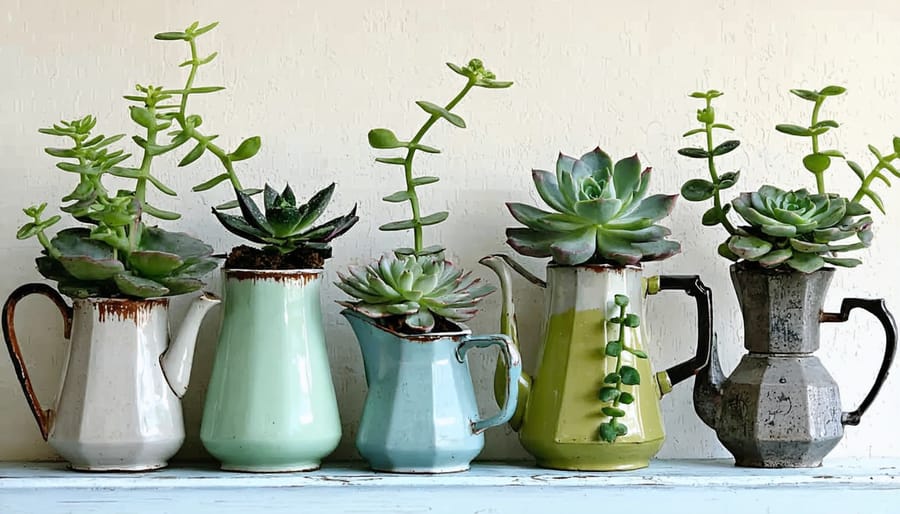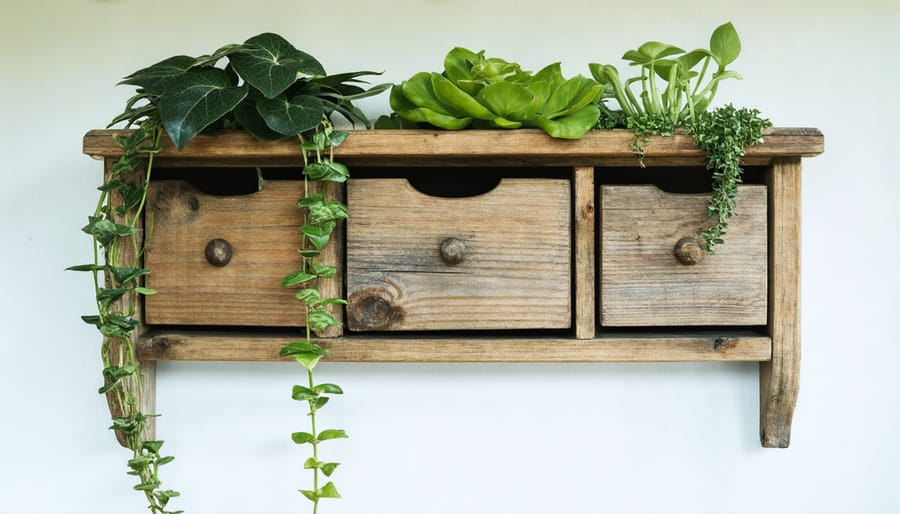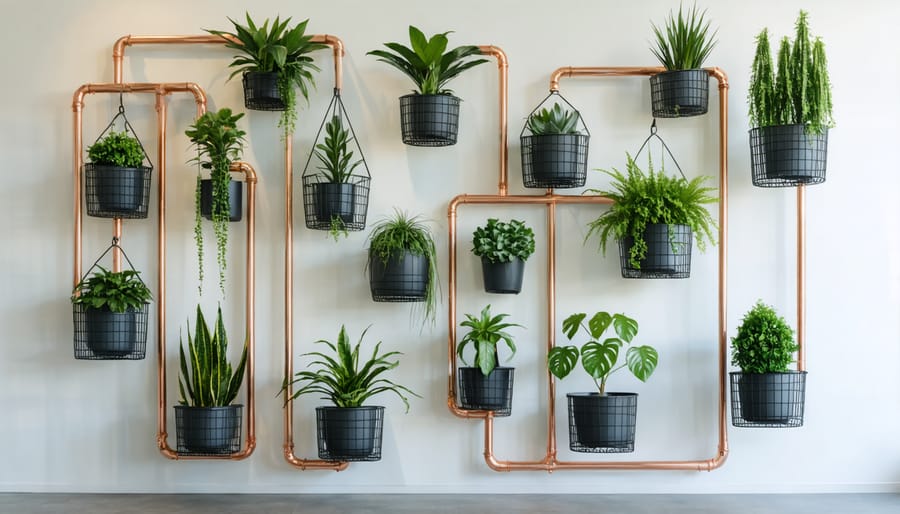Transform everyday objects into stunning plant homes – from vintage teacups and mason jars to repurposed wine bottles and industrial pipe sections. Learning to creatively style indoor plants unlocks endless possibilities for personalizing your space while saving money and reducing waste. Think beyond traditional pots: hollow out old books for succulent gardens, convert antique wooden crates into herb planters, or suspend macramé holders made from kitchen twine. The key lies in matching each container’s unique characteristics – drainage, size, material composition – with your plants’ specific needs. Whether you’re a minimalist drawn to concrete vessels or a maximalist who loves colorful ceramic collections, these unconventional planting solutions merge form and function to create living art that reflects your personal style while nurturing healthy plant growth.
Repurposed Kitchen Treasures
Vintage Teapots and Coffee Containers
Transform your vintage teapots and coffee containers into charming planters for a touch of nostalgic elegance in your home. These unique vessels make excellent creative plant container ideas that blend retro appeal with modern greenery.
Start by selecting containers with character – perhaps that lovely ceramic teapot from your grandmother or those classic metal coffee tins gathering dust in your pantry. Before planting, ensure proper drainage by carefully drilling 2-3 small holes in the bottom using a ceramic or metal drill bit. Line the bottom with a layer of pebbles to prevent soil from washing out.
These vintage vessels work particularly well for smaller plants like succulents, herbs, or compact trailing varieties. Their spouts and handles create interesting visual elements while offering natural support for climbing plants. For teapots, try growing mint or chamomile for a poetic nod to their original purpose.
When arranging your display, mix and match different styles and eras of containers. A collection of mismatched vintage vessels can create a cohesive look when unified by similar plants or color schemes. Position them on windowsills, shelving units, or create a stunning centerpiece for your dining table.
Remember to choose plants that match the container size and consider using plastic liner pots inside particularly valuable pieces to protect them from moisture damage. This way, you can preserve the charm of your vintage finds while giving them new life as beautiful plant homes.

Mason Jar Gardens
Mason jars have become a charming and practical solution for indoor gardening, offering a perfect blend of rustic appeal and modern functionality. These versatile glass containers are ideal for growing herbs, succulents, and small plants, while adding a touch of farmhouse charm to any space.
To create your own mason jar garden, start by selecting jars in various sizes – pint jars work well for most herbs, while quart-sized containers are perfect for larger plants. Before planting, add a layer of pebbles or activated charcoal at the bottom for drainage, as mason jars don’t have built-in drainage holes.
Get creative with your display by mounting jars on wooden boards using pipe clamps, arranging them on windowsills, or hanging them with macramé holders. For an extra special touch, paint your jars with chalk paint or wrap them with twine for added decoration.
Some plants that thrive in mason jars include:
– Mint
– Basil
– Oregano
– Small succulents
– Air plants
Pro tip: To prevent water-logging, water your plants sparingly and monitor soil moisture levels carefully. Consider using a spray bottle for more controlled watering. You can also create a stunning vertical herb garden by mounting multiple jars on a kitchen wall, keeping fresh herbs within easy reach while cooking.
Remember to place your mason jar gardens in spots with appropriate lighting for your chosen plants, and rotate them occasionally to ensure even growth.
Upcycled Furniture Elements
Drawer Planters
Transform old drawers into charming plant havens that add character and greenery to your living space. Whether salvaged from vintage furniture or rescued from yard sales, drawers make surprisingly versatile planters that can be mounted on walls or arranged as standalone pieces.
To create a drawer planter, start by thoroughly cleaning your chosen drawer and drilling drainage holes in the bottom. Apply a water-resistant sealant or line the interior with plastic to protect the wood from moisture. Consider preserving any original hardware or paint for a rustic aesthetic, or give it a fresh coat of paint to match your décor.
For wall-mounted installations, ensure you secure the drawer to wall studs using appropriate brackets and hardware. Remember to account for the weight of soil, plants, and water when choosing your mounting solution. Standing drawer planters can be elevated on hairpin legs or wooden blocks for added height and visual interest.
These repurposed planters work beautifully with cascading plants like pothos or string of pearls, creating a waterfall effect over the drawer’s edges. For deeper drawers, try creating a mini herb garden or combining different plant heights for dynamic appeal.
Pro tip: Old dresser drawers with multiple compartments make excellent divided planters, allowing you to create distinct growing spaces for different plant varieties while maintaining a cohesive look.

Bookshelf Gardens
Transform your old bookshelf into a stunning vertical garden that maximizes space while creating a living wall of greenery. Start by selecting a sturdy bookshelf – wooden ones work best as they can handle moisture and weight. Before adding plants, seal the wood with waterproof varnish to protect it from water damage and extend its lifespan.
Arrange your plants by considering their light requirements – place sun-loving varieties on upper shelves and shade-tolerant plants on lower levels. Use attractive containers that fit the shelf depth, and don’t forget to place saucers underneath to catch excess water. Mix up the heights and textures of your plants to create visual interest – try combining trailing pothos with upright snake plants and bushy ferns.
Make the most of your bookshelf garden by incorporating decorative elements like small sculptures, crystals, or vintage books between plant groupings. For added functionality, install small grow lights under each shelf to ensure all plants receive adequate light, especially in darker corners.
Pro tip: Keep the bottom shelf free for storing watering cans, extra pots, and gardening tools. This creates a practical gardening station while maintaining the aesthetic appeal of your living display. Remember to regularly dust both the shelves and plants, and check for any water damage or wear to maintain your bookshelf garden’s beauty and functionality.

Industrial Chic Containers
Metal Pipe Planters
Transform ordinary plumbing pipes into stunning contemporary planters that add an industrial-chic vibe to your space. These DIY metal pipe planters aren’t just stylish eco-friendly decor solutions, they’re also incredibly durable and customizable.
Start with copper or galvanized steel pipes from your local hardware store, available in various diameters to accommodate different plant sizes. Choose pipes between 4-6 inches in diameter for most houseplants. You’ll need end caps for the bottom, which can be secured with pipe cement or welding, depending on the material.
Before planting, drill several drainage holes in the bottom cap and treat the interior with a rust-resistant coating. For an extra design touch, consider creating geometric arrangements by connecting multiple pipes with elbows and T-joints. You can mount these on walls, let them stand freely, or create hanging installations.
To enhance the industrial aesthetic, leave the pipes in their natural state or spray paint them in metallic finishes, matte black, or bold colors to match your decor. Remember to place a layer of gravel at the bottom for proper drainage, and consider using plastic liner pots inside for easier plant maintenance and protection against corrosion.
Expert tip: For a weathered look, let copper pipes naturally patina over time, or speed up the process using a vinegar solution.
Wire Basket Displays
Wire baskets offer an industrial-chic approach to displaying your indoor plants while maximizing vertical space. These versatile containers bring a perfect blend of vintage charm and modern aesthetic to any room. You can find wire baskets at thrift stores, flea markets, or even repurpose old storage baskets from your home.
To transform a wire basket into a stunning plant display, start by lining it with natural coco coir or moss to prevent soil from falling through. This not only serves a practical purpose but also adds an organic texture to your display. For hanging installations, use strong macramé cords or metal chains – just ensure they’re properly anchored to the ceiling with appropriate hooks rated for the weight.
Consider creating a graduated display with different-sized wire baskets hung at varying heights. This works particularly well in corners or along empty wall spaces. For added visual interest, mix in different plant varieties – trailing pothos and string of pearls look especially striking as they cascade through the wire patterns.
Pro tip: Spray paint your wire baskets in metallic colors or matte black for a more contemporary look, or leave them in their natural state for a rustic feel. Remember to place a plastic saucer at the bottom of each basket to catch excess water during watering.
DIY Natural Materials
Woven Basket Planters
Woven baskets offer a charming, rustic touch to your indoor garden while providing excellent airflow for your plants. To transform a basket into a planter, start by selecting one with a tight weave and sturdy construction. Line the basket with a layer of coconut coir or plastic liner, making sure to poke drainage holes if using plastic.
For a bohemian look, choose baskets with natural fiber variations or interesting patterns. You can easily customize plain baskets by weaving colorful yarn or ribbon through the existing weave. Consider painting sections of your basket with non-toxic paint for a modern twist, or add macramé elements for extra visual interest.
When placing plants in basket planters, remember to use a plastic pot insert or create a moisture barrier to protect the basket material. This helps prevent water damage and extends the life of your planter. Small succulents, trailing pothos, or ferns work particularly well in basket planters.
For added functionality, try mounting your basket planters on walls using sturdy hooks, or suspend them from the ceiling with macramé hangers. Group baskets of different sizes and heights to create an eye-catching display. Don’t forget to place a catch tray underneath if you’re setting them directly on surfaces to protect your furniture from water damage.
Expert tip: Thrift stores and yard sales are excellent sources for finding unique baskets that can be upcycled into beautiful planters without breaking the bank.
Cork and Wood Creations
Cork and reclaimed wood bring a rustic, eco-friendly charm to your indoor garden while giving these sustainable materials a second life. Wine cork planters make perfect homes for small succulents and air plants – simply hollow out the center of a large cork, add a bit of well-draining soil, and nestle your tiny plant inside. For a larger display, collect multiple corks and arrange them in a shallow wooden box to create a miniature cork garden.
Reclaimed wood offers endless possibilities for unique planters. Transform old wooden crates into charming container gardens by adding a waterproof liner and drainage holes. Weathered fence posts can be hollowed out to create natural-looking vertical planters, while salvaged wooden bowls make stunning vessels for trailing plants after being properly sealed.
For a modern twist, try creating a floating shelf planter by adding a shallow groove along the top of a wooden board. Line it with waterproof material, add drainage holes, and mount it on your wall for an eye-catching display of small plants or herbs.
Remember to treat any wooden containers with a plant-safe sealant to prevent rot and water damage. A mixture of equal parts linseed oil and beeswax works well for natural protection. Allow the sealant to cure completely before adding plants to ensure your creative containers last for years to come.
Essential Care Tips
When using unconventional containers for your indoor plants, proper care becomes even more crucial. First, ensure your chosen container has adequate drainage – if it doesn’t come with holes, carefully drill or punch some in the bottom. For containers that can’t be drilled, create a drainage layer using pebbles or activated charcoal at the base.
Monitor water retention carefully in your creative containers, as materials like metal, glass, or plastic behave differently than traditional pots. Check soil moisture with your finger before watering, and adjust your watering schedule based on how quickly the container dries out.
For containers without proper drainage, master the art of bottom watering. Place your container in a shallow dish of water for 15-20 minutes, allowing the soil to absorb moisture from below. This prevents overwatering and root rot.
Consider the container’s size relative to your plant’s needs. Even the most creative vessel should provide enough room for root growth. If using shallow containers, opt for plants with minimal root systems like succulents or small herbs.
Clean and sanitize all repurposed containers thoroughly before use, especially those that previously held food or chemicals. A simple solution of one part bleach to nine parts water works well for disinfecting. After cleaning, let the container air dry completely before adding soil and plants.
Remember to periodically check for signs of container deterioration, particularly with materials like wood or metal that might break down over time. Replace containers if you notice any structural issues that could compromise your plant’s health.
Transforming everyday items into unique plant containers isn’t just about being creative – it’s about expressing your personality and bringing life to your indoor spaces. From vintage teacups to industrial pipe sections, each container tells its own story while providing a home for your beloved plants. Remember to always ensure proper drainage and choose containers that complement both your plants’ needs and your home’s aesthetic. Don’t be afraid to experiment with different materials, colors, and arrangements. The joy of indoor gardening lies in the journey of discovery, so let your imagination run wild. Start small, learn from each project, and watch as your indoor garden grows into a personalized sanctuary that reflects your unique style and creativity.
